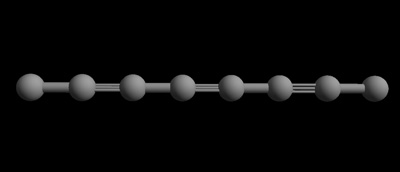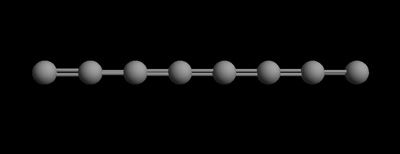|
Graphene is a one-atom-thick planar sheet of
sp2-bonded carbon atoms. Graphene
is the basic structural element of some carbon allotropes
including graphite,
carbon
nanotubes, and fullerenes.
The Nobel Prize in Physics for 2010 was awarded to Andre Geim
and Konstantin Novoselov "for groundbreaking experiments regarding
the two-dimensional material graphene". For a more detailed
description of graphene see our graphene
3D molecule page.
Carbyne
(Linear acetylenic carbon) has been in the news lately as
a structure that is possibly the worlds strongest material
that has great potential if anyone can make it in bulk. Carbyne
is basically a chain of single carbon atoms, but having twice
the tensile strength of graphene , and three times the tensile
stiffness of diamond (1,2). The chemical structure is repeating
chain with alternating single and triple bonds --- ...Because
it is just a single strand of molecules it is often referred
to as "one-dimensional" structure.
 |
|
Image of carbyne with
8 carbon atoms -- a one dimensional chain of carbon
atoms with alternating single and triple bonds
See and manipulate the 3D
structures of carbyne molecules |
or
consecutive double bonds
 |
|
Image of carbyne with
8 carbon atoms -- a one dimensional chain of carbon
atoms with alternating single and triple bonds
See and manipulate the 3D
structures of carbyne molecules |
Physical
Properties of Graphene and Carbyne
Graphene -
1-- graphene is great
conductor; electrons are able to flow through graphene more
easily than through even copper.
2-- Graphene’s near
perfect crystal lattice by restricting the electrons to only
two dimensions, they exhibit the 'anomalous quantum Hall effect'
and 'Klein tunnelling'. (3)
3-- graphene is harder
than diamond and about 300 times harder than steel.
4-- You can stretch
graphene up to 20% of its initial length. It is expected that
graphene’s mechanical properties will find applications into
making a new generation of super strong composite materials
and along combined with its optical properties, making flexible
displays.
5-- Graphene, despite
being the thinnest material ever made, is still visible to
the naked eye. It absorbs a high 2.3% of light that passes
through it, which is enough that you can see it in air.
Carbyne
--
1-- Carbyne
flexibility is somewhere between that of a typical polymer
and double-stranded DNA. And when twisted, it can either rotate
freely or become torsionally stiff depending on the chemical
group attached to its end.(2)
2--Under
appropriate termination, carbyne can be switched into a magnetic
semiconductor state by mechanical twisting.
3-- Carbyne
chains can take on side molecules that may make the chains
suitable for energy storage.
4--Carbyne might be the highest energy state
for stable carbon.
5--If outfitted with molecular handles at
the ends, it can also be twisted to alter its band gap. With
a 90-degree end-to-end rotation, it becomes a magnetic semiconductor.
6--carbyne
can acquire links with side chains, and these chemical bonds
could be made and broken for the storage and release of energy.
7--
Stretching or twisting carbyne changes its electronic properties.
.Source:
see abstract below (Rice University. Theoretical physicist
Boris Yakobson).
References
and Readings
1-Carbyne
from First Principles: Chain of C Atoms, a Nanorod or a Nanorope
-Rice University. Theoretical physicist Boris Yakobson-October
5, 2013
2-New
Form of Carbon is Stronger Than Graphene and Diamond --
MIT Technology Review
3-- Graphene
Properties -- University of Manchester
|

